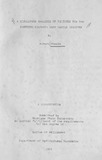| dc.description.abstract | The Atlantic Coast of northern Colombia (known as the
Costa) supports between 40 and 50 percent of Colombia's cattle
population and, with easy access to domestic and world markets,
is the most important of Colombia's five beef-producing regions.
Because cattle raising is the main economic activity in the
Costa and is an extensive operation with low technical
efficiency, the region has been a priority target for cattle
development programs. In the mid-1960s, with the financial
and technical assistance of several international agencies,
the Colombian government started a cattle development program
aimed at increasing beef production mainly on the Atlantic
Coast. In the early 1970s this program was reinforced with
a disease control program and then revised and issued as a
national cattle development plan. The main instruments of
this plan are credit, technical assistance, export subsidies
and improved marketing and slaughtering facilities. Its
long-term objectives are to increase the protein supply to
the Colombian population and to generate foreign exchange
earnings.
The primary purpose of this study was to develop a
system simulation model to (1) analyze the effects of production
incentives on the decision of farmers to adopt new production
methods, and (2) estimate the effects of the expanded regional
production on the income of farmers, government revenues,
Colombian beef consumption and sustained level of exports.
Four alternatives to traditional production were considered.
Alternative 1 considered the improvement of native and artificia
grasses; alternative 2 considered the improvement of artificial
grasses and the substitution of artificial for native grasses;
alternatives 3 and 4 addedthe'production of forages and silage
to the improvement of range lands in alternatives 1 and 2 respectively.
At the present stage of the study, however,
alternative 2 was the only one comprehensively tested and used
as a base run for policy experimentation. The cattle system
simulation model has five major components (including a cattle
demography model) which (1) aliocate land use according to
the farmer's perceived profitabilities of cattle and crops
subject to land and capital constraints; (2) calculate yield
and output of cattle and crops and their respective producer
and market prices; (3) provide the instrumental linkages for
government revenue, export trade policies, and production
campaign policies; and (4) generate the performance criteria
necessary to evaluate the impacts of alternative programs on
the cattle economy through time.
The five major sets of assumptions investigated were
(1) disease control in the traditional herd, (2) alternative
cattle industry taxing policies, (3) alternative development
credi t policies, (4) alternative Levels of government production
campaign promotion, and (5) alternative cattle pricing and
export policies. The results of the cattle policy experiments
were discussed in terms of the projected time paths (from 1966-:
to 1985) of five of the most important performance indices
incorporated in the model: (1) regional cattle population,
(2) Colombian beef consumption per capita, (3) regional farm
income from cattle, (4) capitalized grazing land value per
hectare, and (5) annual regional government revenue from
cattle. Experiments with disease control and export promotion
policies each used two indices instead of the above
five: regional cattle population and extraction ratio for
the disease control policies and domestic market price of
finished males and export margin for the export policies.
In general, the study demonstrated that (1) the
projected outcomes with the government disease control
campaign were greater than under precampaign practices in
the traditional herd; (2) the projected outcomes with
government programs easing development loan terms were in
all cases greater than the base run which assumed current
credit policies; (3) the projected area in improved land and
the modern cattle population with government policies benefiting
both the traditional and modern operations were in all
cases lower than under policies benefiting only the modern
operation; (4) the projected area in improved land with the
increased land tax rate was greater than the base run which
assumed current land tax rates; (5) the projected outcomes
with the removal of special taxes on cattle were lower than
the base run which assumed no removal of these taxes; (6)
given the assumptions on farmers' decisions and accounting
mechanisms in the model, availability of credit for land
improvement does not seem to be a serious constraint to
land modernization; and (7) the projected outcomes with a
flexible exchange rate suggest that this is an effective
incentive to export without involving large transfers from
public revenues to exporters in the form of subsidies.
The study indicated areas where more research and
regional data are needed to improve the model's performance,
and discussed possible extensions that could help analyze more
fully alternative policy strategies for the Costa's overall
development. Finally, the study demonstrated that the system
simulation approach with a computerized model of the cattle
economy which incorporated information from diverse sources
and accounted explicitly for the dynamic interactions and
feedbacks that might occur can be a very useful methodological
tool for policy analysis | en |

